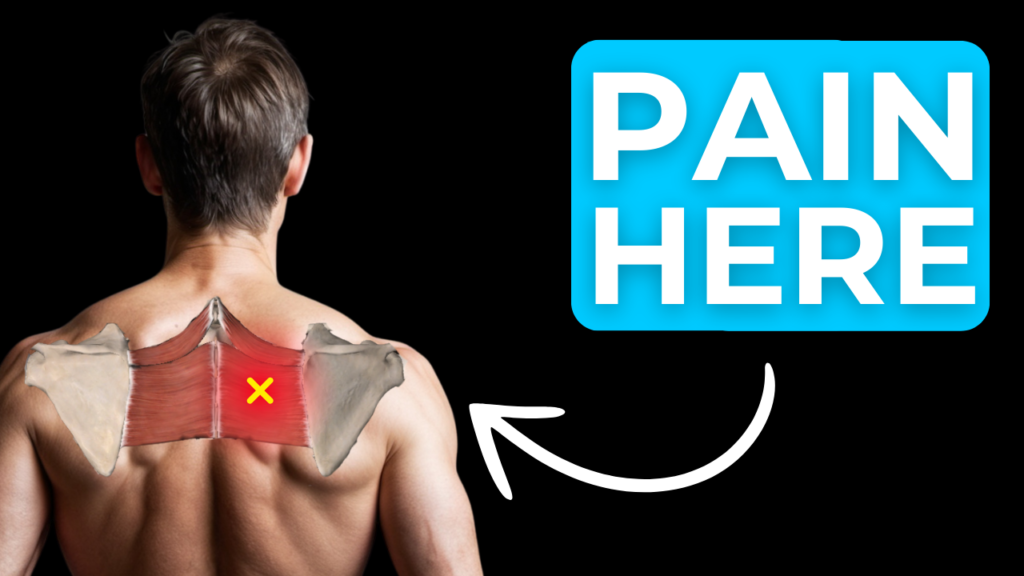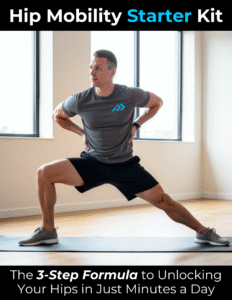
How Do You Relieve Rhomboid Pain? – Mobility Suite
- Dr. Mitch Israel
- Movement & Pain, Posture, Shoulder

Exercises for Rhomboid Pain Relief
Do you often feel pain or tightness right between your shoulder blades? If so, you may be dealing with rhomboid muscle pain. The rhomboids are key muscles that connect your spine to your shoulder blades, playing a crucial role in posture and upper back stability. When these muscles become tight, overworked, or strained, they can lead to persistent discomfort.
So, how do you effectively relieve rhomboid muscle strain and maintain long-term relief? The answer lies in using a structured approach like the Functional Mobility Formula, which consists of four steps: Recognize, Reduce, Restore, and Reinforce. By following this method, you can ease rhomboid pain, improve mobility, and prevent future strain. Let’s break it down step by step.
If you prefer videos, watch the video version below!
Why Does the Functional Mobility Formula Work?
Many approaches to relieving rhomboid muscle pain focus only on short-term relief, such as massage or temporary stretching. While these methods help, they don’t address the underlying movement restrictions or weaknesses that contribute to pain. The Functional Mobility Formula systematically reduces tension, restores joint motion, and reinforces strength, ensuring long-term relief.
Here’s how each step works:
Step 1: Recognize the Problem
Before addressing rhomboid muscle strain, it’s important to identify its root cause. Common symptoms include:
Pain or tension between the shoulder blades, especially near the spine.
Discomfort when moving the neck, mid-back, or shoulders.
A sensation of muscle knots or tightness in the upper back.
Baseline Tests
To determine if your rhomboids are the problem, perform these simple tests:
Neck Rotation Test: Turn your head side to side. Do you feel tightness or pinching between your shoulder blades?
Thoracic Rotation Test: Sit tall and twist your upper body to each side. Do you feel restricted or uncomfortable in the upper back?
Shoulder Mobility Test: Raise your arms overhead or retract your shoulder blades. Any pulling or discomfort in the upper back may indicate rhomboid pain.
Taking note of these symptoms and limitations will help you track progress as you go through the routine.
Step 2: Reduce Tension
To alleviate rhomboid muscle pain, we first need to reduce tightness in the area. One of the best stretching exercises for rhomboids involves posterior expansion breathing.
Posterior Expansion Breathing with a Yoga Ball
Hug a yoga ball tightly, compressing the front of your rib cage.
Roll forward until your shoulder blades point toward the ceiling.
Breathe deeply through your nose and exhale through your mouth, imagining filling the space between your shoulder blades.
Perform 10-15 deep breaths, relaxing further into the stretch with each exhale.
Alternative Without Equipment
Start in a low quadruped (hands-and-knees) position.
Round your upper back as if making a “turtle shell.”
Focus on deep breathing into your upper back.
Perform 10-15 breaths, expanding the ribs with each inhale.
This method effectively reduces muscle tension in the rhomboids, thoracic spine, and rib cage.
Step 3: Restore Range of Motion
Now that we’ve reduced tension, the next goal is to restore normal movement in the upper back. One of the best stretching exercises for rhomboids is the Open Book Stretch.
Open Book Stretch
Lie on your side with your top knee bent at 90 degrees and pinned to the ground with your bottom hand.
Place your top hand on your chest and slowly rotate your torso, opening your chest.
Breathe in deeply and exhale as you rotate further.
Perform 8-12 reps per side, trying to increase your range of motion with each rep.
This exercise helps mobilize the thoracic spine and reduces rhomboid muscle strain by improving movement mechanics.
Step 4: Reinforce with Strength and Stability
To maintain relief and prevent future rhomboid pain, strengthening the area is essential. Try this low quadruped stability exercise.
Low Bear Hold with Scapular Stability
Get into a low quadruped position with your hands forming a diamond near your forehead.
Shrug your shoulders up, then depress them to “pack” the shoulder blades.
Lift your knees slightly off the ground into a hover position.
Hold for 30 seconds, focusing on controlled breathing.
For an easier alternative, perform Low Bear Rises:
Start in a low quadruped position.
Push your hips up slightly, loading the shoulder girdle.
Lower back down and repeat 10-15 reps.
These exercises help strengthen the rhomboids and surrounding stabilizers, ensuring lasting relief from rhomboid muscle pain.
Bonus: Reassess Your Progress
After completing this routine, reassess your symptoms:
Has your rhomboid pain decreased?
Do you feel more mobility in your thoracic spine and shoulders?
Have the baseline tests improved?
If so, you’re on the right track! Consistency is key—perform this routine 3-4 times per week for long-term results.
Why This Approach Works
The Functional Mobility Formula effectively tackles rhomboid muscle strain by systematically reducing tension, restoring motion, and reinforcing strength. Unlike quick-fix methods, this approach ensures lasting relief and improved movement quality.
If you’ve been struggling with rhomboid pain or chronic tightness, start incorporating these stretching exercises for rhomboids into your routine. For personalized guidance or persistent symptoms, consider consulting a movement specialist.
By recognizing, reducing, restoring, and reinforcing, you can relieve rhomboid muscle pain and prevent it from returning. Stay consistent, and you’ll not only experience relief but also build long-term resilience in your upper back!





